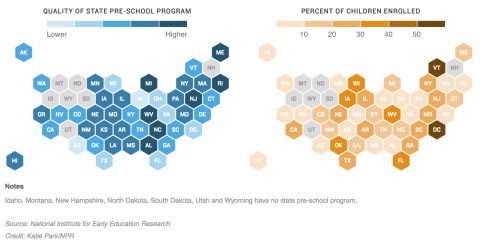What is Giving Compass?
We connect donors to learning resources and ways to support community-led solutions. Learn more about us.
More states than ever are providing publicly funded preschool. That's according to a new report from the researchers at the National Institute for Early Education Research, or NIEER, who have been tracking state preschool policies and programs since 2002.
In 2016, the report found, 43 states, plus the District of Columbia and Guam, provide publicly funded preschool. They serve about 1.5 million children across the country — mostly 3- and 4-year-olds. Total state spending on preschool is now about $7.4 billion, an eight percent increase over last year. That increase has pushed spending to nearly $5,000 per child.
Last year 24 states increased spending per child. California and Texas saw some of the biggest increases.

Preschool got a pig push under the Obama Administration — and the federal preschool development grants that totaled $210 million last year were a big help.
Steve Barnett, head of NIEER, says the numbers are encouraging, but he cautions that the quality of most preschool programs is still very uneven.
"The growing inequality between states that have moved ahead and invested in quality preschool programs and states that have done nothing is really stark."
Barnett says the reasons for that vary. Funding is a good example.
Washington, D.C., spends $15,748 per child. Mississippi spends less than $2,000 per child, roughly half of what states spend on average.
The disparities in enrollment are pretty pronounced as well.
Florida, Oklahoma, Wisconsin and the District of Columbia each serve more than 70 percent of their 4-year-olds. Another 18 states serve more than a third of these kids (New York City is considering universal preschool for 3-year-olds as well).
Seven states, NIEER says, don't fund preschool at all.